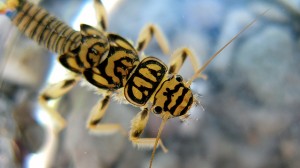
This post was written by guest blogger McKenzie Powers who is working with HRWC this year through the University of Michigan’s Undergraduate Research Opportunity Program. McKenzie is researching indicators of climate change in rivers.
It is mid-January and we southeastern Michiganders have been quite spoiled thus far with fairly mild winter conditions. While we are feeling more familiar conditions currently, temperatures in the mid 40’s over the holidays with little snow to date kept it feeling more like autumn than winter. Although, us folks at the Huron River Watershed Council are feeling curious and slightly concerned about what these warmer temperatures mean in relation to one of our most climate sensitive aquatic buddies, the stoneflies.
With our annual Stonefly Search quickly approaching, we have been busy with our noses deep in piles of research trying to gain a better understanding of how stoneflies are affected by a changing climate. Macroinvertebrates, including stoneflies, are important in freshwater ecosystems because of the many different jobs they perform, which include processing of organic matter, nutrient cycling, and decomposition. Stoneflies are known to be one of the most vulnerable groups of aquatic insects because of their specific needs related to temperature and dissolved oxygen. Several traits common in stoneflies make them particularly susceptible to impacts from climate change. They have limited dispersal potential and therefore have difficulty migrating to areas with more suitable conditions. They are large bodied with less efficient respiration than some other types of aquatic insects so dissolved oxygen needs are high. The highest dissolved oxygen levels occur in cold and flowing waters. They also have lower reproductive capacity making populations more susceptible to impacts from drought in warmer months when eggs can be damaged from warmer, drier conditions.
A study conducted in 2014 by scientists from the University of Duisburg-Essen, used a multi-trait approach to assess the climate change vulnerability of stoneflies and other macroinvertebrates. Researchers created a vulnerability scoring system with those least vulnerable scoring a 0 and those highly vulnerable scoring a 6. Species vulnerability was measured by analyzing temperature preference, altitude preference, stream zonation preference, life history, and a few other factors. The results showed that 60 species of stoneflies were recorded with a vulnerability score of 4 or more.
HRWC has collected stonefly data for 21 years. We can look at this data not only for signals of pollution but also of climate change. We are currently grazing the literature for our ‘canaries in the coalmine’. Are there ways we can look at our stonefly data to see where and how climate change is impacting our macroinvertebrate community? Are the strategies we are employing to help the Huron River system adapt to climate change actually working? With projected climate change and temperatures on the rise, these data collections give us insight on our current water quality and help us determine strategies for a cleaner and more favorable future.
Join us this weekend in our efforts to collect stoneflies from throughout the watershed. Registration closes today. Visit http://www.hrwc.org/volunteer/stonefly/ to register!
_________



